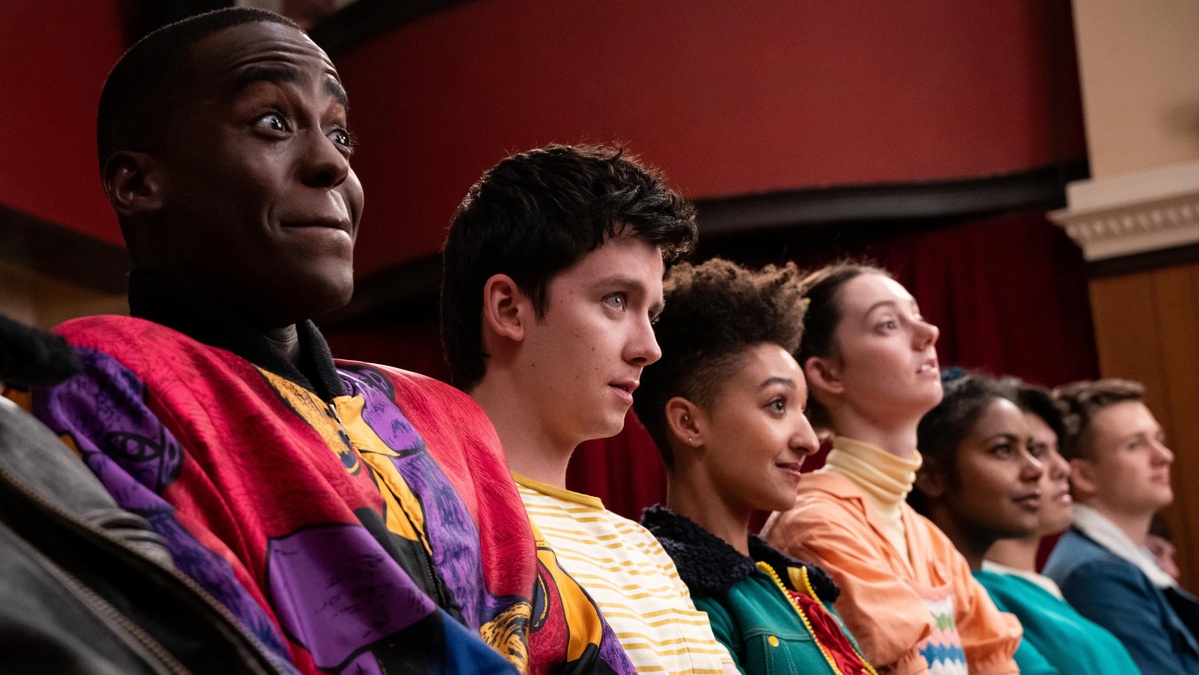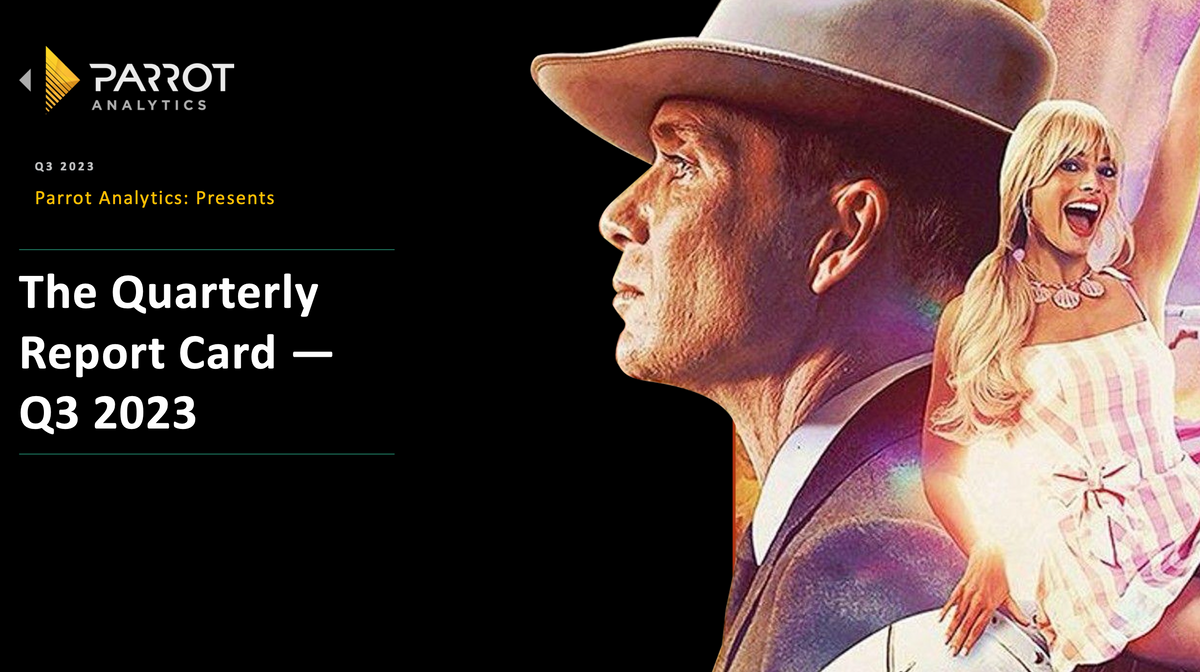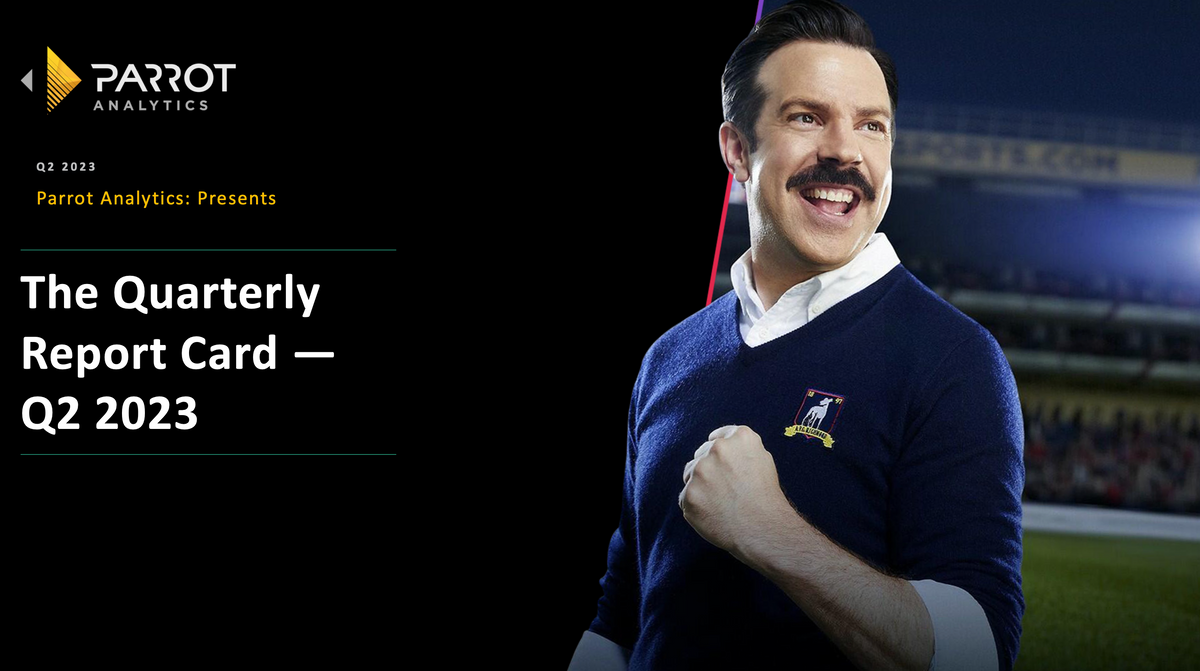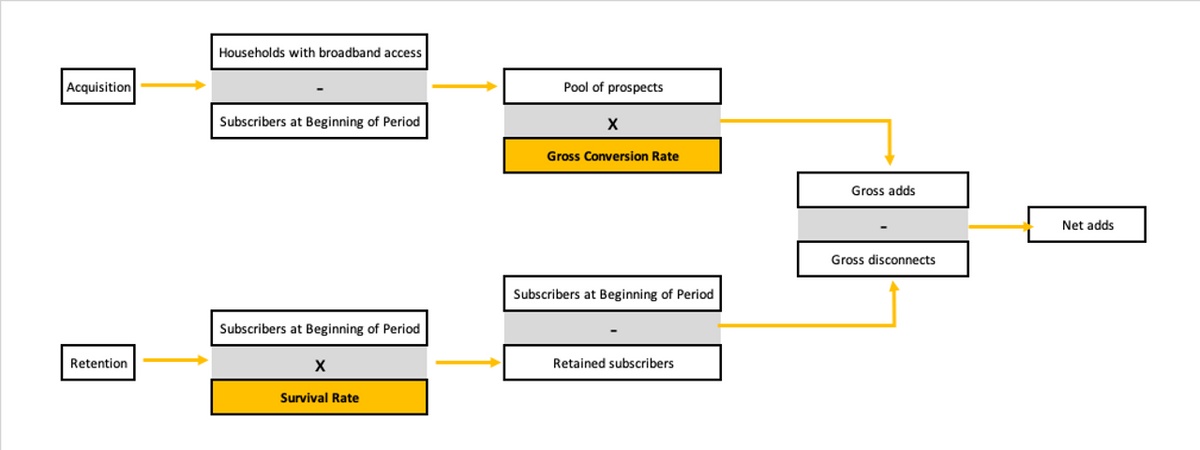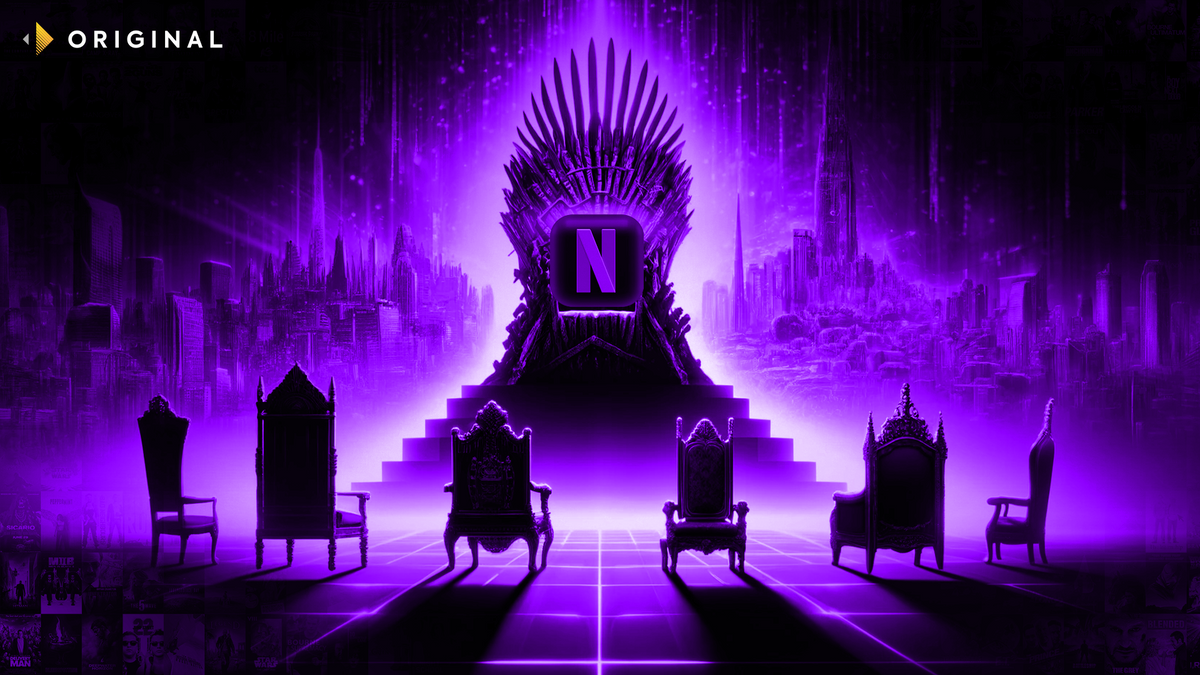By reading this article you will learn:
- How Netflix is reevaluating its film strategy.
- What the company's new approach to original movies will be.
- The risks and rewards involved with this new course.
In many ways, the entertainment industry is like Game of Thrones (minus everything that makes Thrones cool) in the sense that the seats of power are in a constant state of flux and an omnipresent state of dread hangs over everyday proceedings. As those that wield influence rise and fall, new outlooks for the realm, new strategies to be deployed, and the hope for sustained prosperity rise and fall with them. Westeros cycles through power brokers almost as rapidly as Hollywood, and it’s no different for Netflix.
Scott Stuber led the market-leading streaming company’s film division from 2017 to March of this year. Now, producer Dan Lin has assumed the vaunted role. The former oversaw a Netflix that aggressively sought growth; the latter will help steer a company maturing from infancy to adolescence. Both required distinct and divergent strategies.
“The aim is to make Netflix’s movies better, cheaper and less frequent,” the New York Times reported of the transition. No one in Hollywood history has ever attempted the bold strategy of only delivering cost-effective hits, I’m sure. But will Netflix truly get more bang for its buck this way?
To answer this, we will:
- Examine where Netflix’s original film division has previously found success and run into challenges
- Explore the outlook for the new strategy
- Identify how broader industry shifts play into the overall value picture
- Offer a few recommendations of our own
Scott Stuber Era
We forget that in 2017, when Stuber first joined Netflix, the company had only been releasing original films for two years. As both a new entrant into a film world long dominated by cozy incumbents and, more importantly, a streaming service with the audacity to step into the realm of cinema, Netflix’s “big screen” ambitions were largely met with apprehension if not outright derision from the wider industry.
Yet Stuber, armed with a deep reservoir of resources, succeeded in buying Netflix legitimacy and validation over his seven year run. The studio has earned eight Best Picture nominations at the Academy Awards and 23 wins overall. It became known as a talent-friendly destination that could support the creative dreams of A-list figures. That translated to a steady stream of releases with notable upfront buzz over the years. As of Q1 2024 in the US, Netflix led all services in movie catalog demand share at 8.2% of the total demand for SVOD platforms (though this also includes licensed titles).
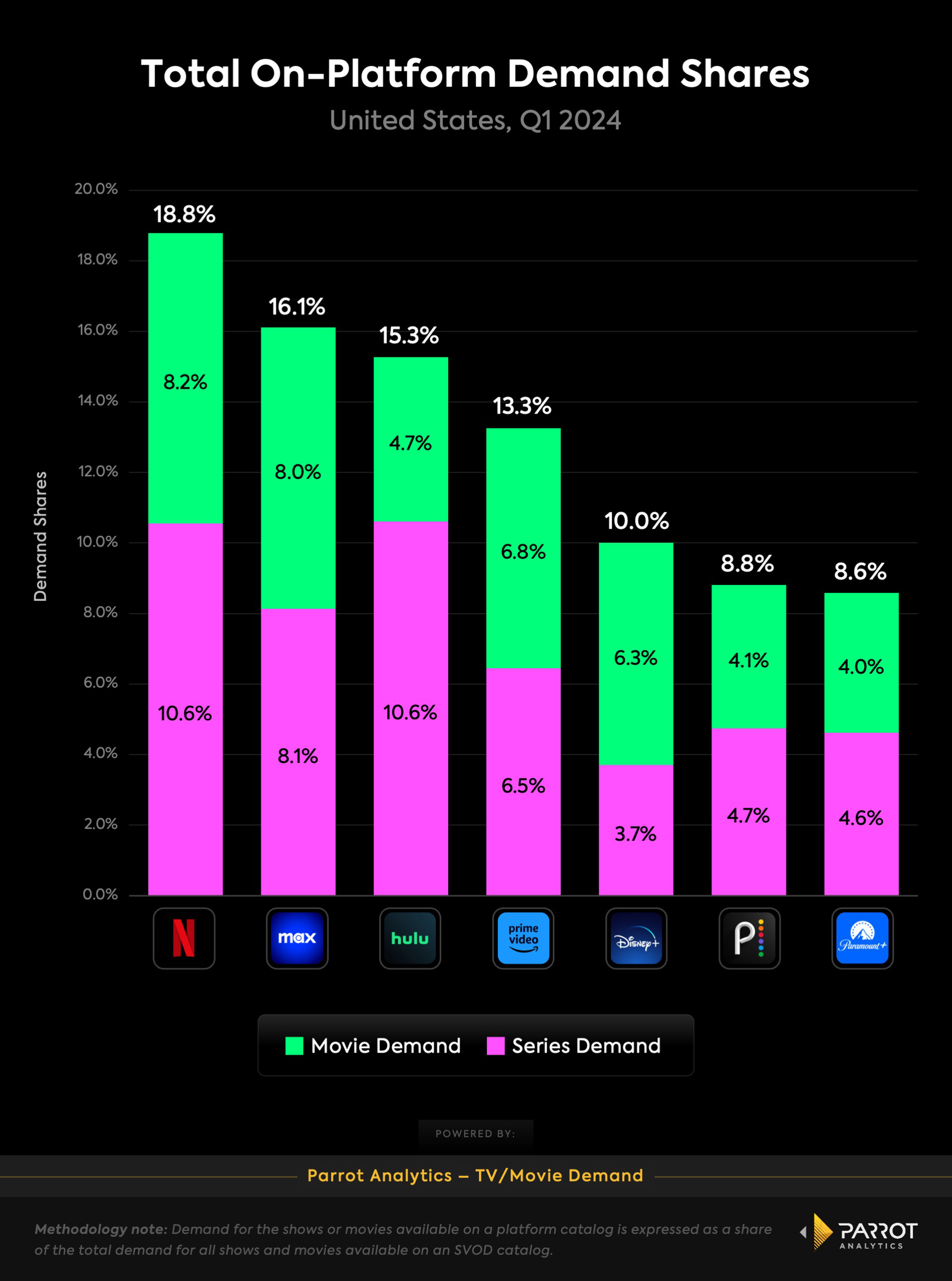
When looking at just Netflix’s catalog, total movie demand share has increased quarter-over-quarter in six of the last eight quarters. From Q1 2022 to Q1 2024, the company’s movie demand share has jumped more than 13%. All of this is a fancy way of saying that Stuber succeeded in growing Netflix’s movie success.
The first problem with this success, however, is that it came at great cost. Netflix delivered an average of more than 221 scripted original films (both English and non-English) in the US from 2019-2023, according to What’s on Netflix. That sort of volume is unsustainable financially and arguably overwhelming to consumers. Titles such as Red Notice ($200 million), The Adam Project ($116 million) and The Gray Man ($200 million), Rebel Moon ($166 million), Triple Frontier ($115 million) and others all carried reported nine-figure budgets. The company also shelled out $465 million to acquire the rights to two Knives Out sequels.
Hits often cost money. But without any notable box office returns, it’s fair to question the value of straight-to-streaming blockbusters as well as the scores of smaller films that barely chart.
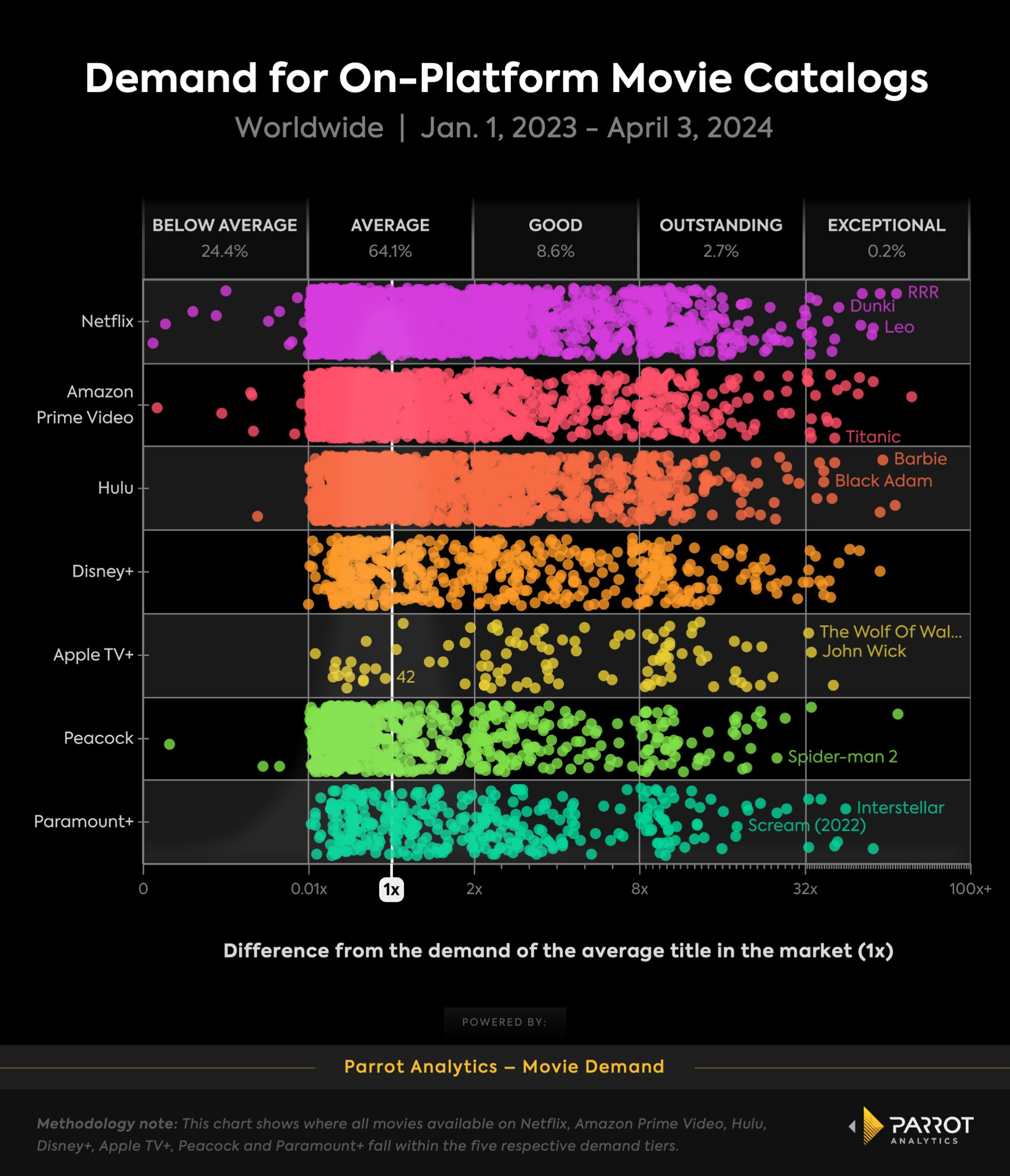
The other problem with this fire hose approach is the lack of quality control. Netflix sits last among the major SVOD services in hit rate, which measures sentiment for films, with 64% of titles falling into the “Average” category, according to Parrot data. This leads to a number of forgettable films that don’t generate much viewership or demand, as evidenced by Netflix’s own Engagement Report. (The top 1,000 TV/Movie titles out of 18,000, or roughly 5%, accounted for nearly 60% of all viewing in the six month period). This can also lead to the company’s popular films quickly falling out of relevancy in the greater pop culture conversation. Netflix ranked last behind Universal, Sony, Fox, Paramount, Warner Bros. and Disney in terms of the percentage of films that maintained significant public interest for more than five months, per The Wall Street Journal.
As of Q1 2024, Netflix original movies accounted for 25% of the platform’s total movie catalog in the US market, a significant increase from the 20% it saw in Q3 2022. Despite this, just one Netflix original movie ranked among the 50 most in-demand films worldwide from January 1, 2020-April 3, 2024.
Hence the strategic shakeup. Netflix wants its movies to make a more prolonged impact across a diverse array of genres without breaking the bank each time out.
Dan Lin Era
Despite the volume, demand share for original Netflix movies in the US has declined in each of the last two quarters. In fact, supply of original movies now exceeds demand, suggesting investment should be pulled back.
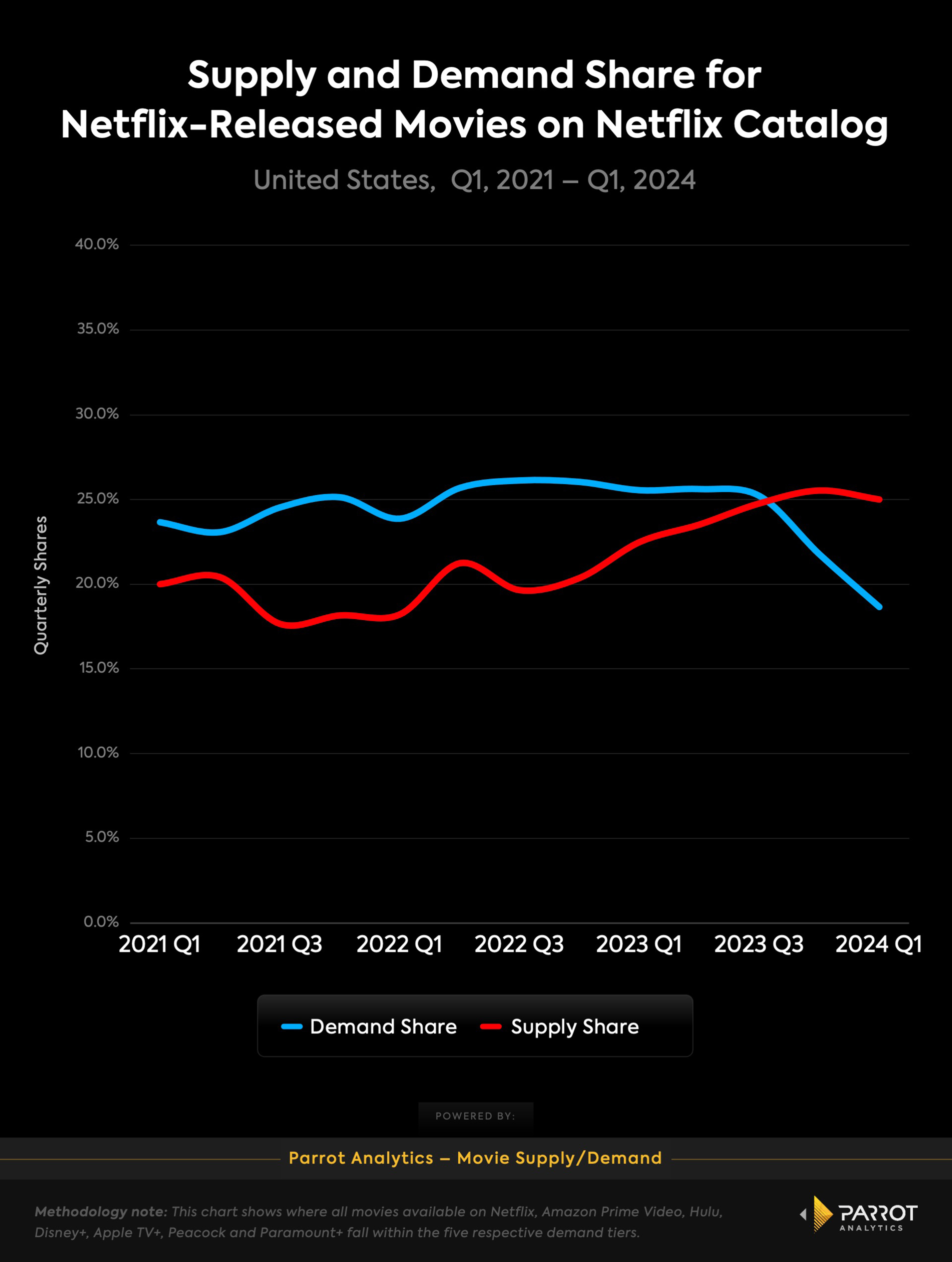
Lin is reportedly expected to make “about 20-30 movies a year for Netflix,” according to Puck, marking a significant downturn from the Stuber era (though this likely only refers to English language films). These will be “majority midsized offerings, where Netflix has found its biggest hits with comedies, rom-coms and family films,” The Hollywood Reporter curiously reports despite the fact that Netflix’s 10 most-watched English and Non-English films are largely expensive star-driven and/or high concept genre titles.
Admittedly, Jennifer Lopez’s The Mother, which reportedly cost just $40 million, earned its way into the Top 10 last year. But chart topping viewership and demand are not always synonymous with profitability, which looks to be Netflix’s primary concern moving forward. That’s where the divide comes into play.
When looking at Netflix’s total movie catalog over the last three quarters — including licensed titles — Drama (22%), Comedy (17%) and Thriller (9%) account for the three largest supply shares, according to Parrot Analytics’ Content Panorama. Romance (8%) and Family (4%), two of the movie genres Netflix reportedly wants to emphasize more, are comparatively smaller.

Stuber was consistent in his output as the supply share of movies on Netflix by genre remained mostly static from Q3 2021 to Q1 2024. This may partially explain why Netflix wants to rejigger its focus and somewhat move away from genre-oriented blockbuster dramas which tend to cost a pretty penny. Film strategy across all the major studios is often fluid and reactive to the times, after all.
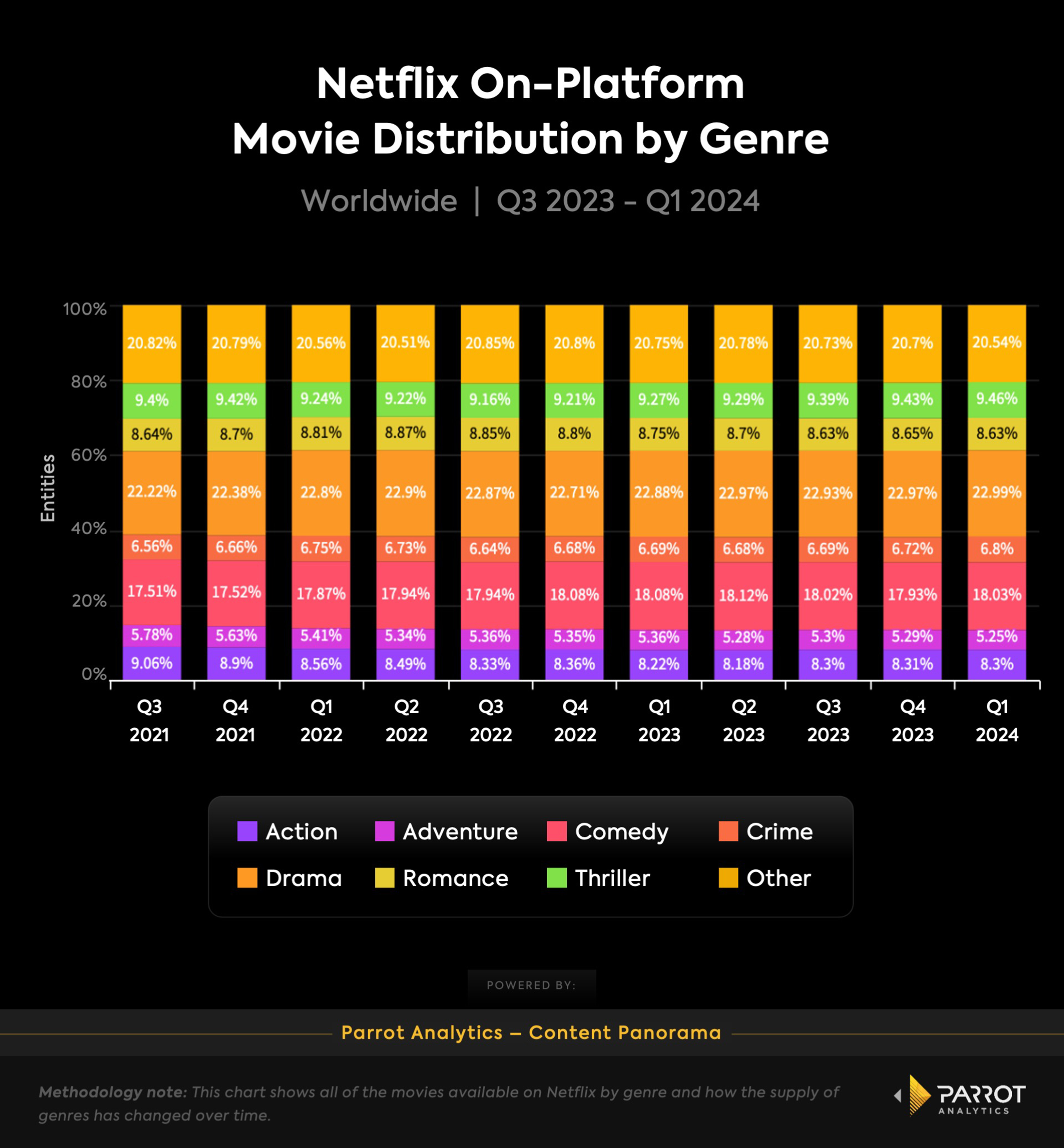
These less expensive family films, teen dramas, romcoms and holiday pictures (Klaus remains a modern classic) tend to generate stronger ROIs than the so-called blockbusters, though often not as much raw viewership and demand. Holiday-specific films such as Netflix’s annual batch of Hallmark-style Christmas movies and the recent Lindsay Lohan-led St. Patrick’s Day romcom Irish Wish are a particularly reliable sub-genre. Irish Wish spent three consecutive weeks among Netflix’s Top 10 most-watched English films, racking up more than 100 million hours of global viewership (according to Netflix) and averaging 12.88x more demand than the average film in the US in that span. Given its likely low cost, this is a strong performance. The thinking behind the company’s overall transition may be that three or four mid-sized offerings like this can bring in as much traffic collectively as one big blockbuster.
One issue with this strategy is that Hollywood is a hits-driven business in which the home runs are far more valuable than the singles and doubles. The Adam Project, Netflix’s third most-watched English original film in global hours viewed, was 59.54x more in-demand worldwide than the average movie title in its first month of release. That’s multiples better than smaller 2023 offerings such as We Have a Ghost (24.05x), The Cloned Tyrone (24.83x) or Reptile (31.03x). Trying to re-create the viewership and demand of blockbusters in the aggregate with more modestly priced features requires a guaranteed hit rate. Even if that were possible, it isn’t likely to drive as much buzz and growth as the tentpole titles.
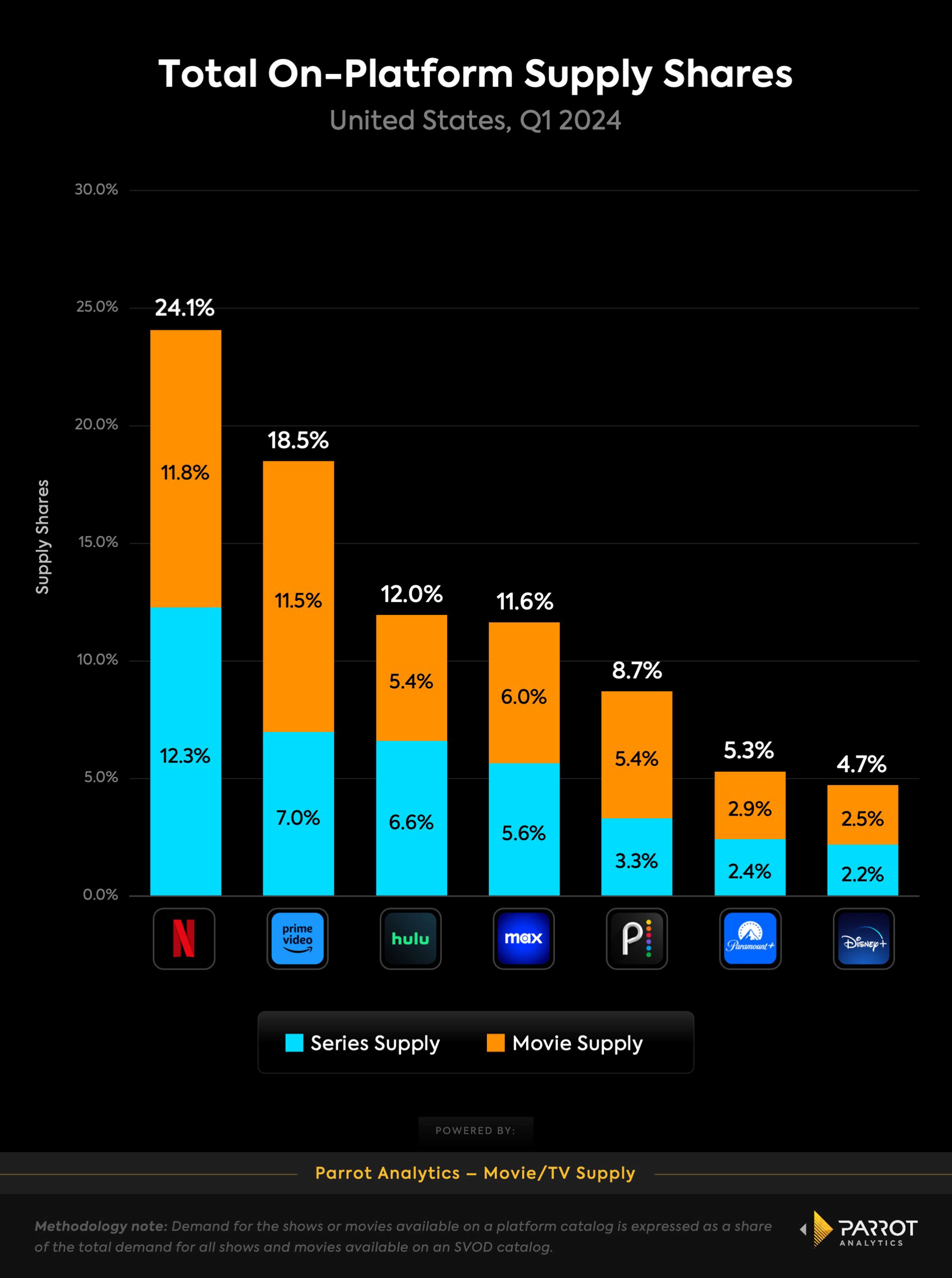
Another issue: movies with an easier path to profitability don’t always solve for Netflix’s quality problem. Irish Wish, for example, has a 5.2/10 on IMDb, a 44% on Rotten Tomatoes and a 46% on Metacritic. Reptile (6.8/10, 45%, 52%) didn’t fare much better. These are…suboptimal ratings. Providing something for everyone, which has been Netflix’s modus operandi for years, makes it difficult to cultivate a quality brand. That’s partially why Netflix will be more discerning moving forward.
“Netflix is still willing to spend, just not as much and not on everything,” per Puck.
TV Is More Valuable to Netflix Than Film
Any potential downsizing of Netflix’s original film ambitions may also be a tacit acknowledgment that TV series drive more value than movies overall. To be clear, movies are still of great importance to SVOD libraries for a number of reasons, as HBO/Max chief Casey Bloys told Parrot Analytics. Given that 70% of Netflix’s total subscriber base comes from outside of the UCAN market, while roughly 80% of quarterly subscriber additions are now international, it has a clear incentive to continue building overseas market share. But Netflix itself may even understand that from a resource allocation standpoint, original TV series are more efficient than a waterfall of original straight-to-streaming movies. At least, that’s what the data implies.
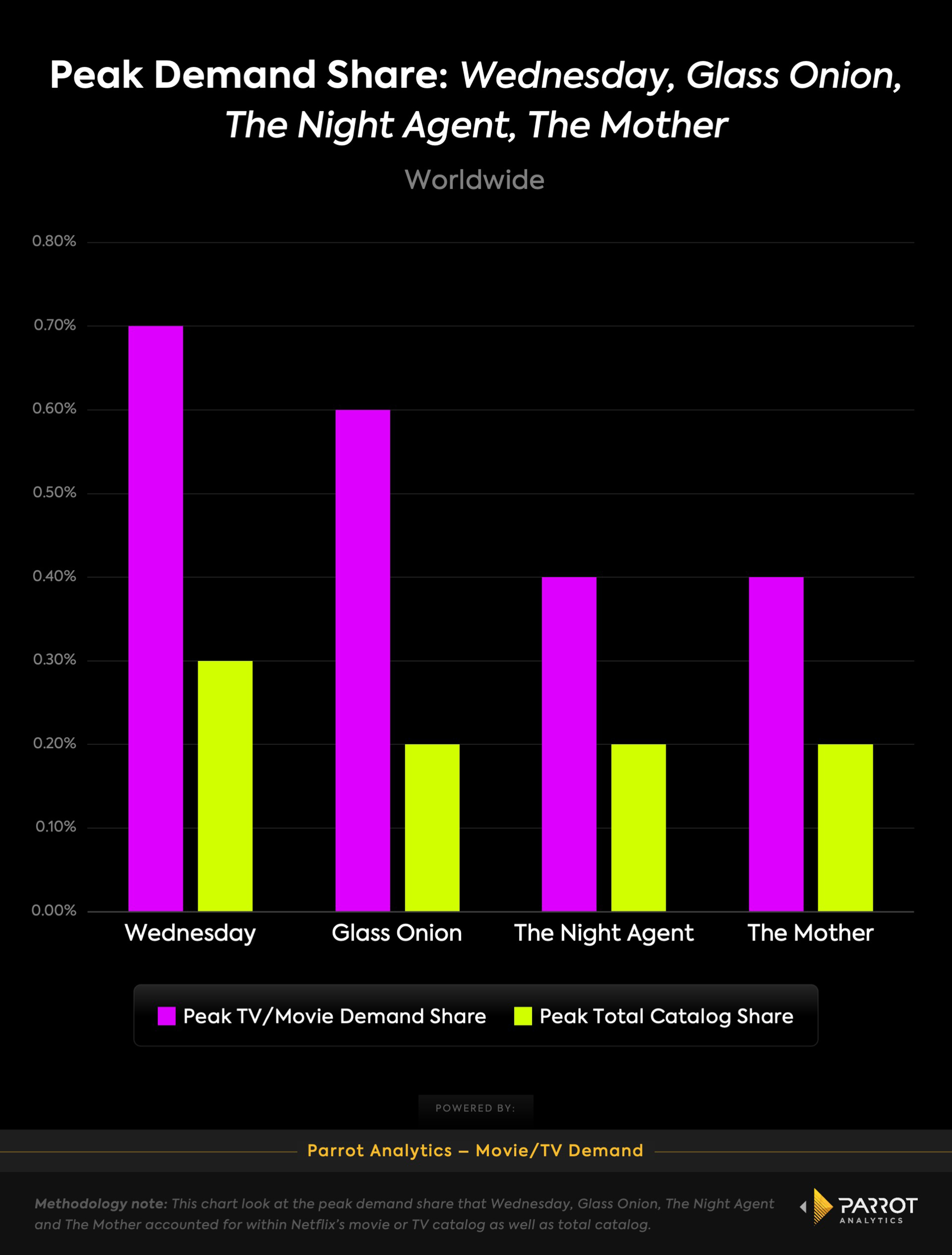
Wednesday (1.71 billion global hours viewed) and Glass Onion: A Knives Out Mystery (320.3 million) are both among Netflix’s Top 10 most-watched English TV seasons/movies and they both were released on the platform in late Q4 2022. In that quarter, Netflix reported 7.6 million global net subscriber additions and $7.852 billion in revenue globally. This included $3.595 billion in revenue and 74.3 million subscribers in the United States in Canada. According to Parrot Analytics’ Streaming Metrics data estimates, around $3.3 billion of that revenue and nearly 67 million subscribers came from the US alone
Of course, an entire slate contributes to these numbers, not just two titles. Yet Glass Onion accounted for 0.2% of all Netflix movie demand and 0.1% of total catalog demand that quarter. Wednesday generated 0.6% of all TV demand and 0.3% of total catalog demand. Both titles peaked in the next quarter (Q1 2023), with Glass Onion sitting at 0.6% of all Netflix movie demand and 0.2% of total catalog demand while Wednesday topped out at 0.7% of TV demand and 0.3% of total catalog demand. During their respective runs, Glass Onion peaked as the 17th most in-demand movie worldwide while Wednesday reached No. 1 overall.
Another pair of Netflix Top 10s, The Night Agent and The Mother, reached equal peaks in Q2 2023, when Netflix reported 5.89 million global net subscriber additions and $8.18 billion in worldwide revenue. Yet unsurprisingly, The Mother (265.9 million) totaled less global hours viewed overall than The Night Agent (803.2 million) while peaking as the 32nd most in-demand movie globally compared to the latter becoming the 17th most in-demand TV series.
In each instance, the TV series contributed more revenue driving, subscription growth, and customer retention value and/or hours of viewership while usually accounting for a larger share of catalog demand than the movies.
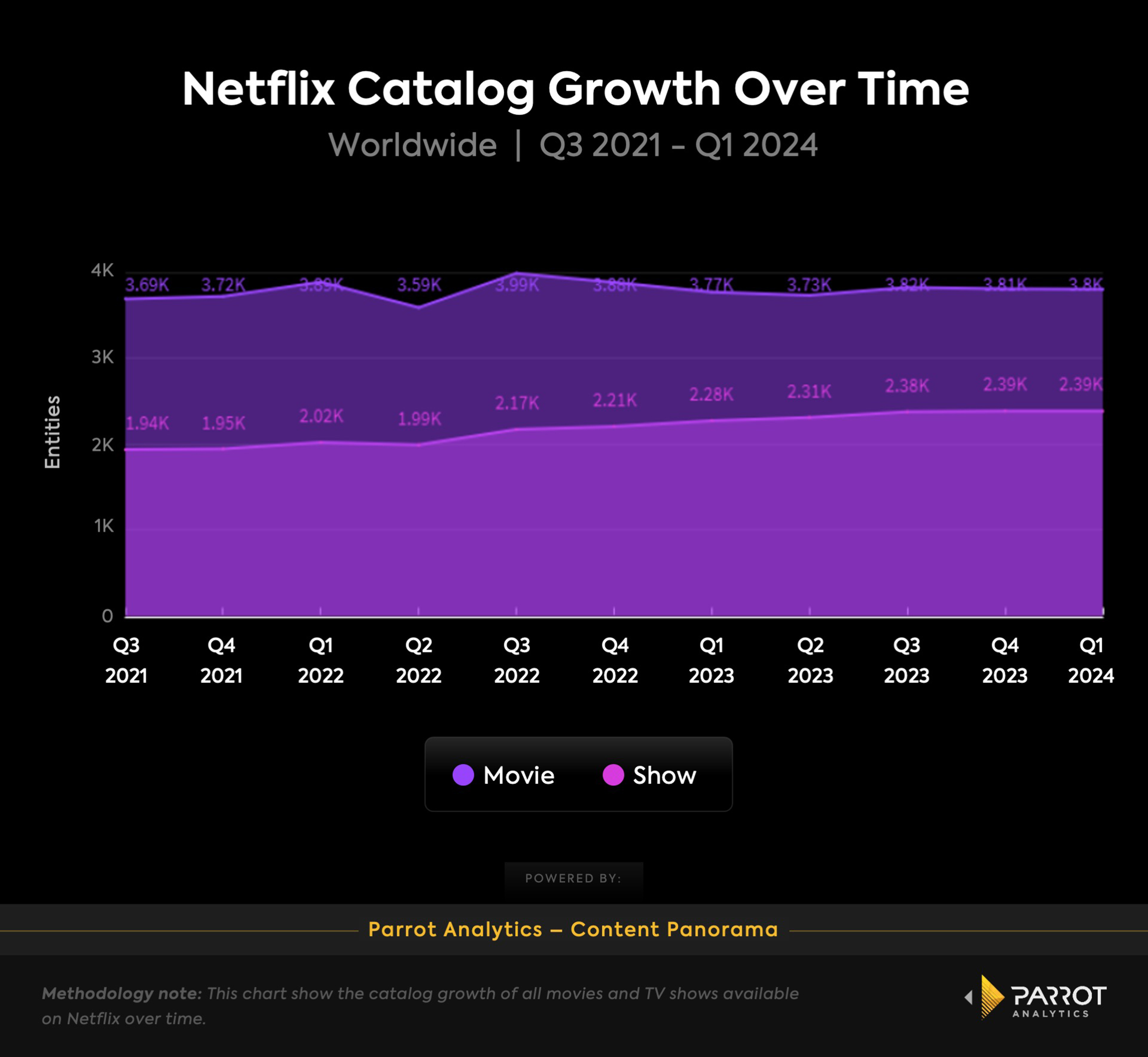
When looking at Netflix’s total catalog (both original and licensed movies and TV shows) from Q3 2021-Q1 2024, the number of TV shows available on the platform has been increasing steadily while the number of movies remains relatively flat. This has resulted in a declining movie supply share within the streamer’s total catalog.
This is reflected in the disparity between TV’s demand share within Netflix’s total catalog vs movie demand share. From Q1 2022 to Q1 2024, TV demand share on the platform exceeded movie demand in every single quarter.
In other words, audience attention is drawn more towards the streamer’s prodigious catalog of TV series than it is towards movies overall. That’s not entirely surprising as TV shows tend to offer more hours of potential consumption than films and an easier pathway to multi-hour binge sessions. Subscribers are also much more likely to open a streaming app multiple times a week to watch a single TV show compared to typical one-and-done movie consumption.
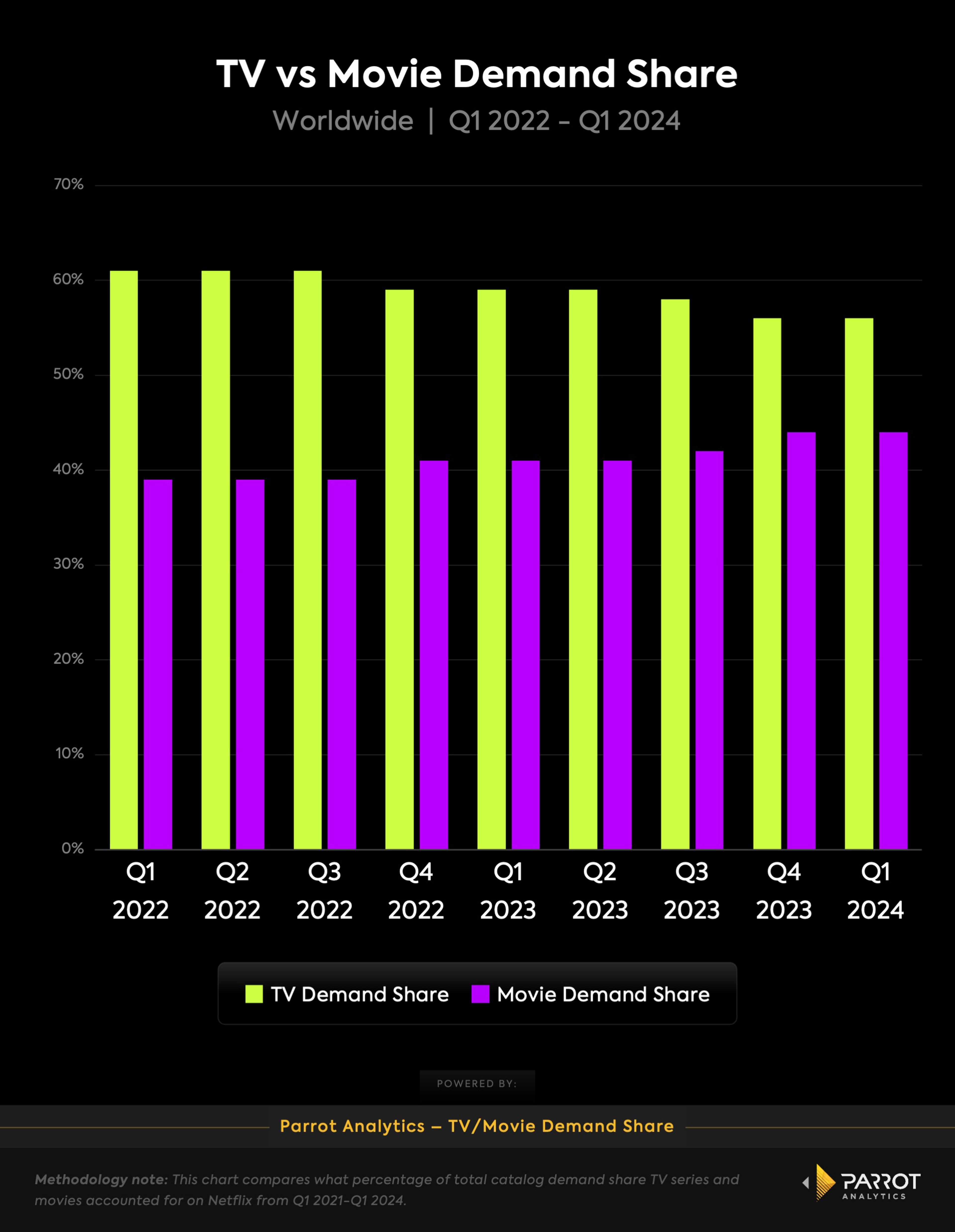
This trend carries over to decay rate, or how fast the demand for a show drops after the release of a new season. In terms of comparison points for TV shows, we look at in-season, which covers the first month of a binge-release series, to post-season, which counts the next four weeks, as well as post-season to off-season, which would cover the demand change between the post-season up until a new season begins. For movies, we compare periods of 45 days.
Among Netflix’s top 50 original seasons for in-season to post-season TV decay rate, the average season lost 32.5% of its demand in these eight weeks. For the post-season to off-season decay rate, the average was -46.7%. The top 50 Netflix original movies saw a drop of 49% of their average demand after the first 45 days of release and a drop of 26.0% in the period of 90 to 135 days when compared to the period of 45 to 90 days after release. The decay rate between demand from day 90 to day 135 after the movie released and the first 45 days is a whopping -77%.
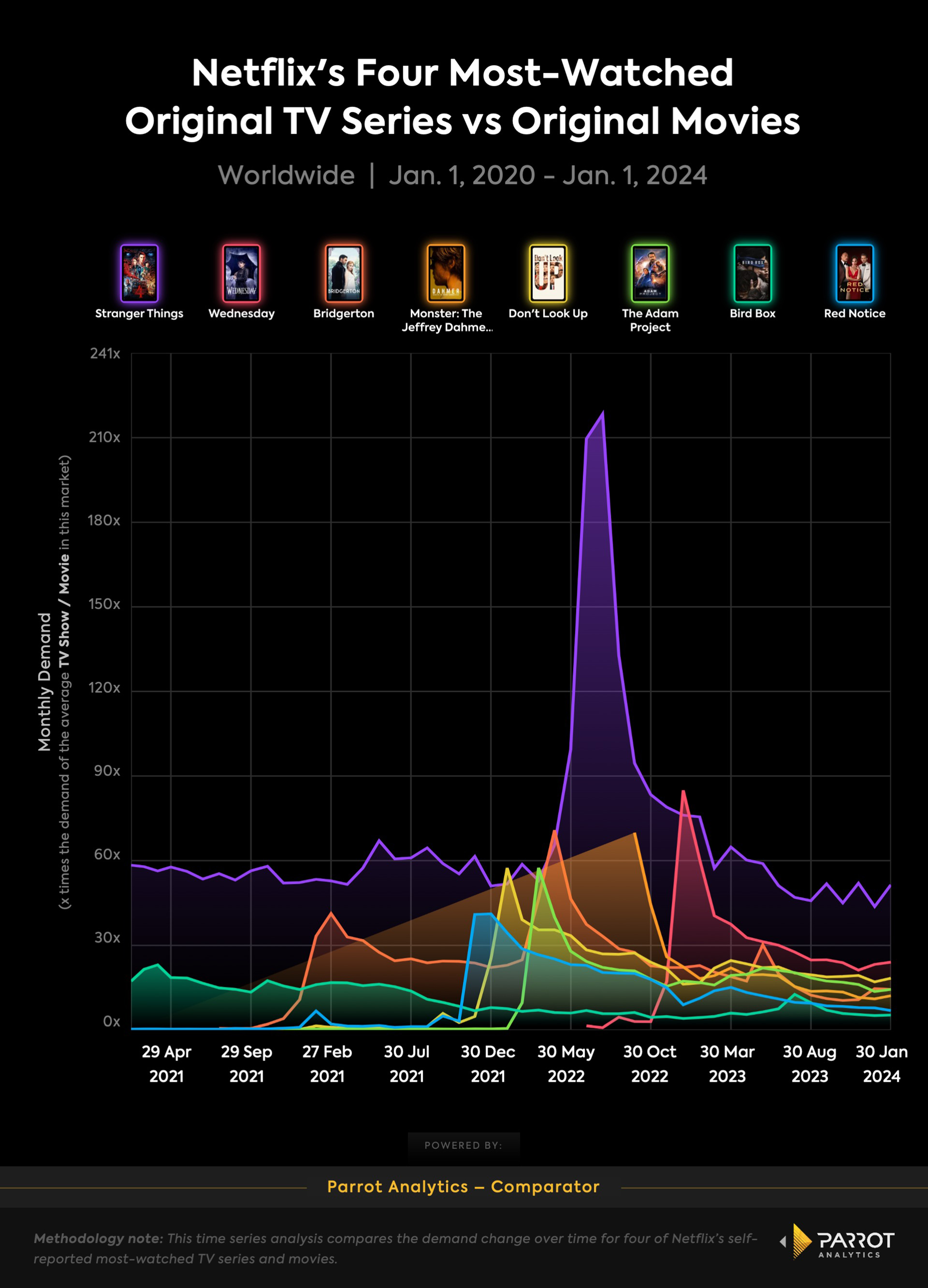
Netflix original movies also tend to reach peak demand slightly quicker than original TV series as 62% of Netflix’s top 50 films hit their demand ceiling within its first five days of release, compared to 58% of TV shows in the top 50. There’s a reason that TV demand is more closely linked to subscriber growth than movie demand.
TV series tend to sustain audience interest over longer periods of time than movies, which helps increase retention and reduce churn. Rerouting a portion of the content budget from original film to TV looks to be a more efficient use of resources. It leaves more money available for other innovations (such as the company’s continued video games campaign) as opposed to maintaining significant spend on re-acquiring lost subs.
(Of course, a pullback in original film from Netflix would not be ideal for Hollywood as a whole. After Disney’s acquisition of Fox and Paramount Global’s uncertain future, we are facing the prospect of just four legacy movie studios remaining in earnest. Any reduction from the streamers would leave fewer buyers and funding opportunities on the open market. But this is a topic for another day).
Experiments to Consider
Stuber’s exit and Lin’s appointment represents a time of change for Netflix. As such, here are a few data-backed suggestions for the streamer as it ventures out into a new era of film strategy.
Consider Releasing Animated Films Theatrically
Okay, we get it, Netflix, you don’t want to do wide releases for big budget blockbusters like Red Notice or Rebel Moon in theaters nor surefire theatrical bets such as the Knives Out sequel (which apparently performed quite well in limited release). But what about carefully selected animated kids movies?
Netflix’s original animated films have failed to generate comparable global hours viewed and estimated completed views vs. licensed animated theatrical fare, according to the company’s own self-reported viewership data. And from Jan. 1, 2020-Dec. 31, 2023, the average of the 10 most in-demand animated movies worldwide was 25.72x while the average for Netflix’s 10 most in-demand animated original films in that same span was 11x. They just don’t compare.
Considering that 60% of Netflix households worldwide watch Kids & Family content every month on the platform, per Netflix, that needs to change.
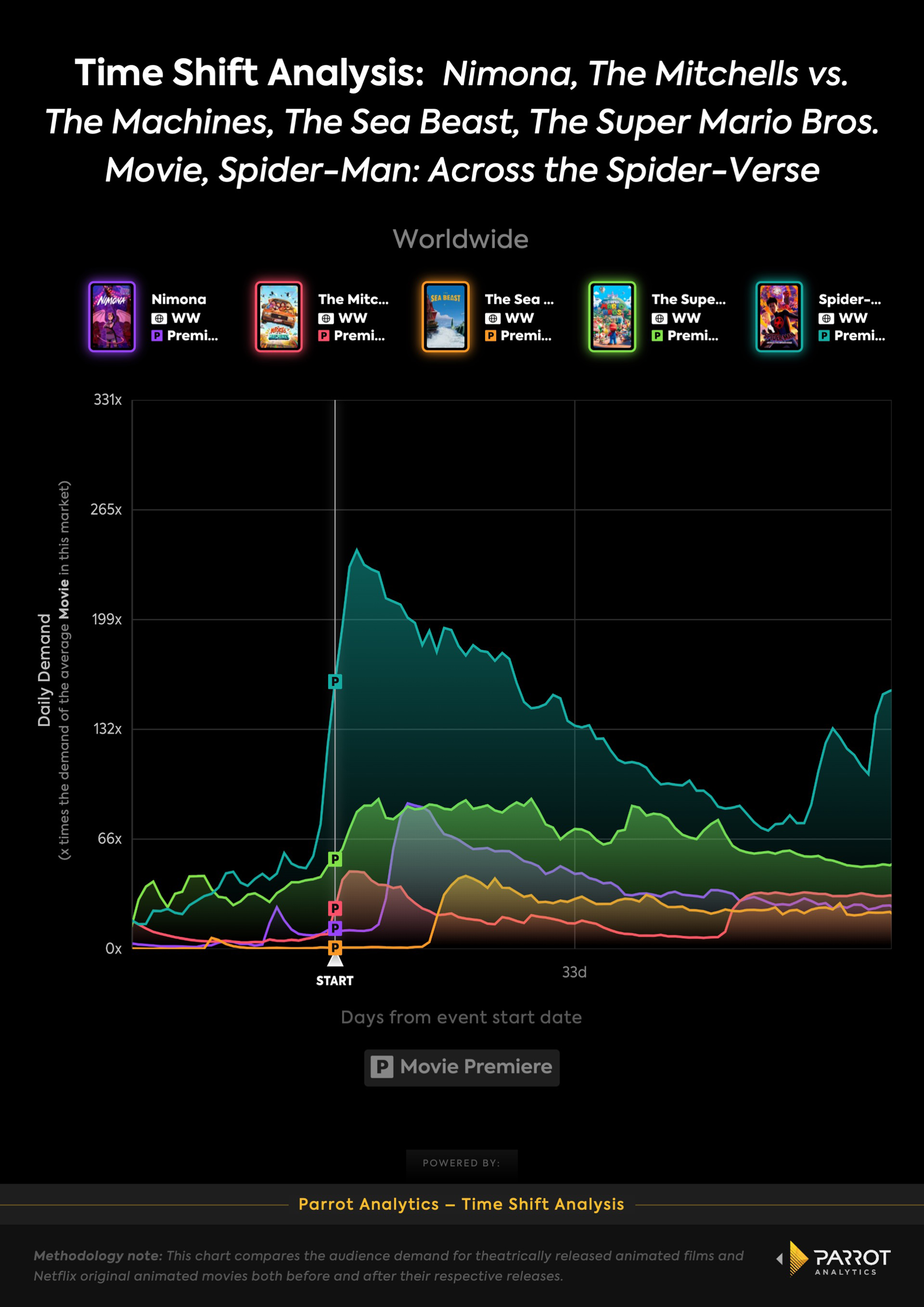
In the last five years, excluding 2020, a minimum of one animated film has ranked among the 15 highest domestic grossers every year while animation typically accounts for a 15%-20% domestic market share annually, per The Numbers. We know that Netflix is serious about the medium after swiping Skydance Animation away from Apple. Former CEO Reed Hastings even said “We want to beat Disney in family animation,” back in 2021.
Yes, it is expensive and risky to put a film in theaters. But theater owners are desperate for fresh product. In the currently challenged climate, they would treat Netflix as a hero riding to the rescue as opposed to the unwanted interloper the company was viewed as in the 2010s.
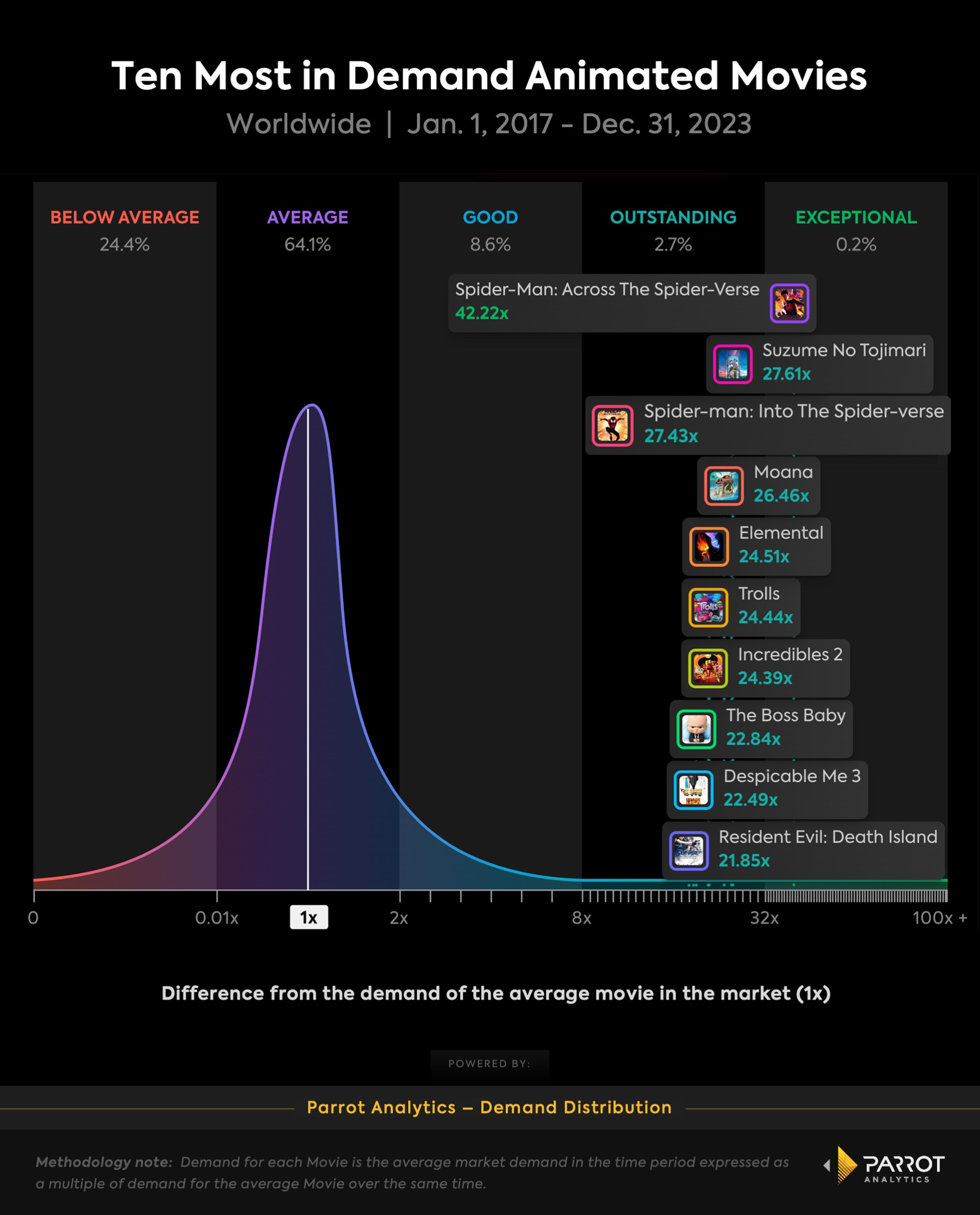
The creative community feels Netflix’s animation division “could benefit from a more hands-on leadership and a heartier approach to development and production — something Lin could provide, and seemed to signal he wants to do,” TheWrap reports.
Netflix has always viewed the film business through its own lens and there is hardly a 1:1 correlation between a movie’s success on the platform and success via ticket sales. But might Adam Sandler’s family friendly Leo, which generated more than 146 million hours of global viewership in its first month of availability and was one of Netflix’s 10 most in-demand original films in Q4 2023, had a shot at grossing $100 million? I think so.
At least exploring the option of releasing certain family friendly animated films could help Netflix develop a stronger cultural footprint with their movie output, generate additional revenue and potentially more subsequent SVOD viewership (while also pleasing talent).
Don’t Overextend on Prestige Films
Netflix has seen nine of its original films score a nomination for Best Picture at the Academy Awards: Don’t Look Up, The Trial of the Chicago 7, Maestro, Mank, Marriage Story, The Irishman, All Quiet on the Western Front, The Power of the Dog and Roma. Just two of these movies (Don’t Look Up, All Quiet on the Western Front) are currently among Netflix’s 10 most-watched English and Non-English films of all time, suggesting a general viewership ceiling for awards hopeful films.
Two of these films (The Trial of the Chicago 7, Mank) were less than 11x more in-demand than the average movie titles in their first month of release. From Jan. 1, 2020-April 3, 2024, the ten most in-demand movie titles on Netflix globally overall were an average of 10% more in-demand than the Best Picture nominees in their first four weeks. Just one of the 15 most in-demand movies available on Netflix since Jan. 1, 2020, regardless of original studio, notched a Best Picture nomination.
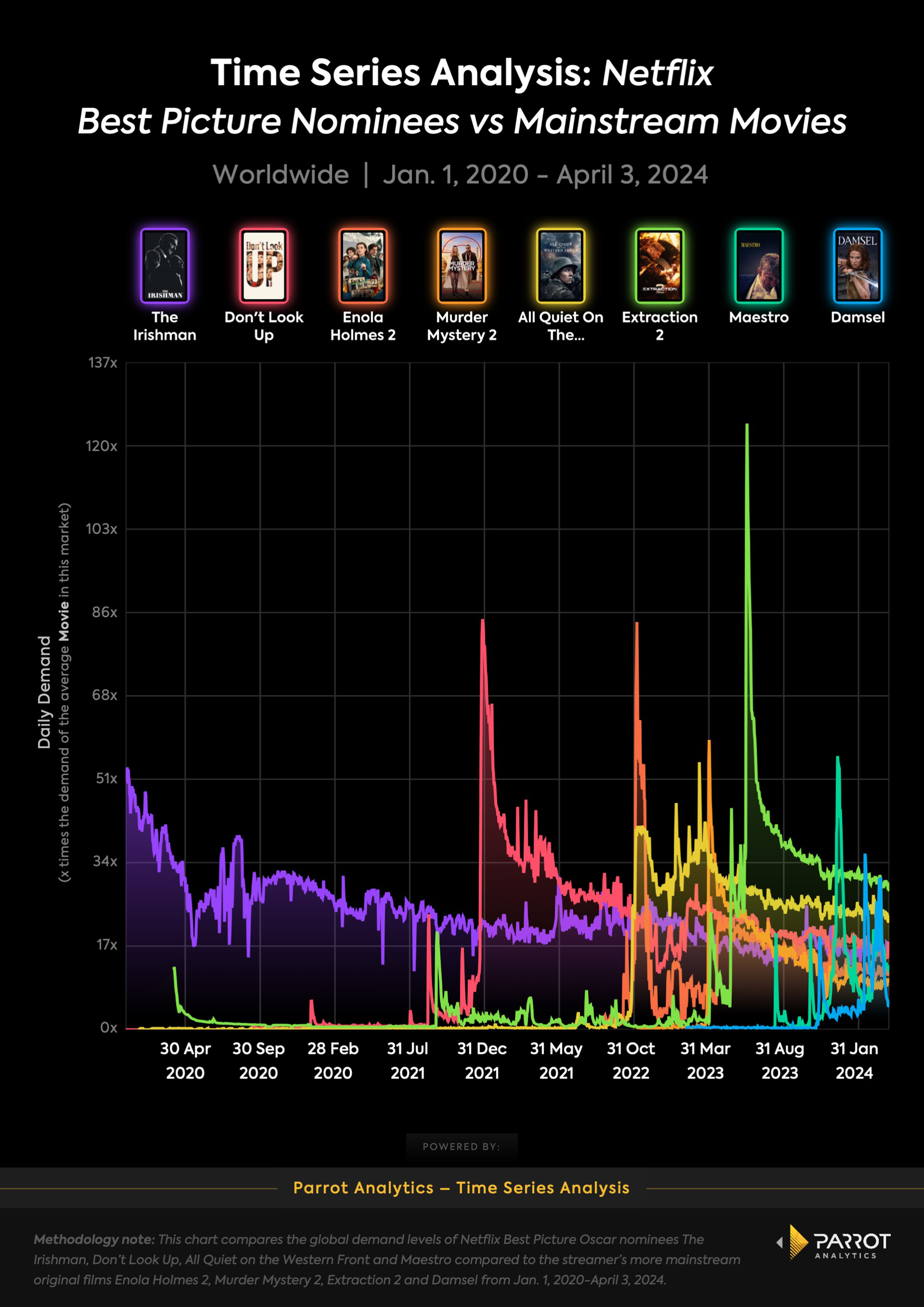
More importantly, prestige films tend to suffer large decay rates. The nine Best Picture nominees lost an average of more than 34% of demand between the first month of availability and the second. Sustaining audiences closer to a Bird Box (-28%), Red Notice (-27%) or Murder Mystery (-23%) over the first two months of availability is integral for extracting full value out of a movie title.
On the TV side, there’s a reason Chief Content Officer Bela Bajaria has moved away from critically acclaimed niche programming to the more broad appeal “gourmet cheeseburgers.” The recent closure of high-minded entertainment studio Participant Media is also another unfortunate nail in the coffin of financially feasible socially conscious media. None of Netflix’s awards hopeful films of 2023 aside from the criminally overlooked Nimona — which it rescued from a different studio and still needed to put on YouTube for free to juice interest — made much of a dent.
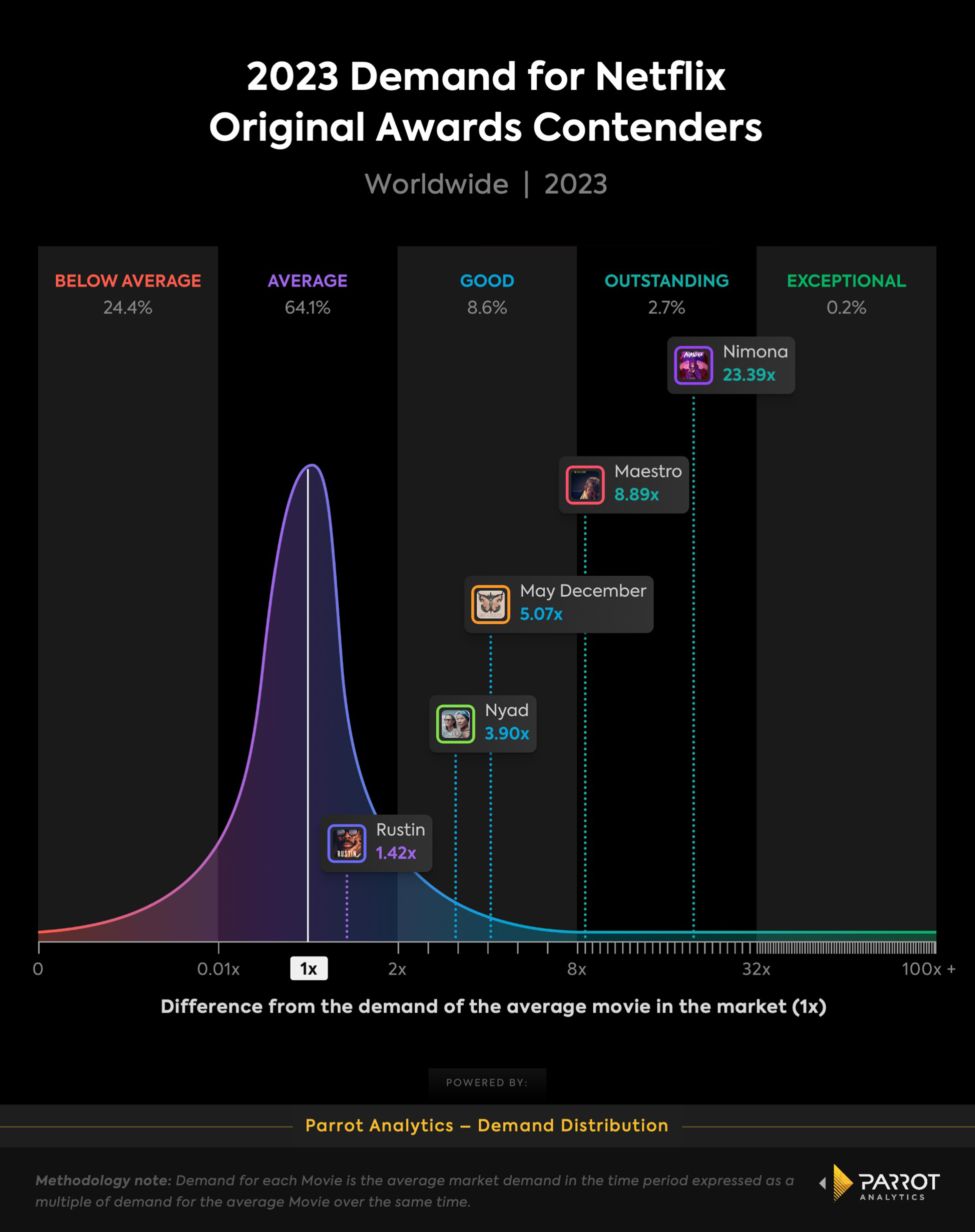
Given that Netflix may or may not be spending around $100 million on Oscars campaigns, in addition to the costs of the movies themselves, the viewership and demand generated by some of these prestige films may not always justify the cumulative price tags. Netflix shouldn’t abandon prestige films altogether — remember, the company is still forging and building filmmaker relationships for the long haul, and awards hopefuls can absolutely still become commercial hits — but the streamer could benefit from a more focused approach.
Licensed Content Can Help With Franchise Focus
Warner Bros. Discovery, Comcast (NBCU), and Disney programming have started contributing a larger percentage of demand shares on Netflix over the last year as the third-party licensing market has re-opened after years of in-house consolidation. Licensed content accounted for 45% of all viewership in Netflix’s first Engagement report.
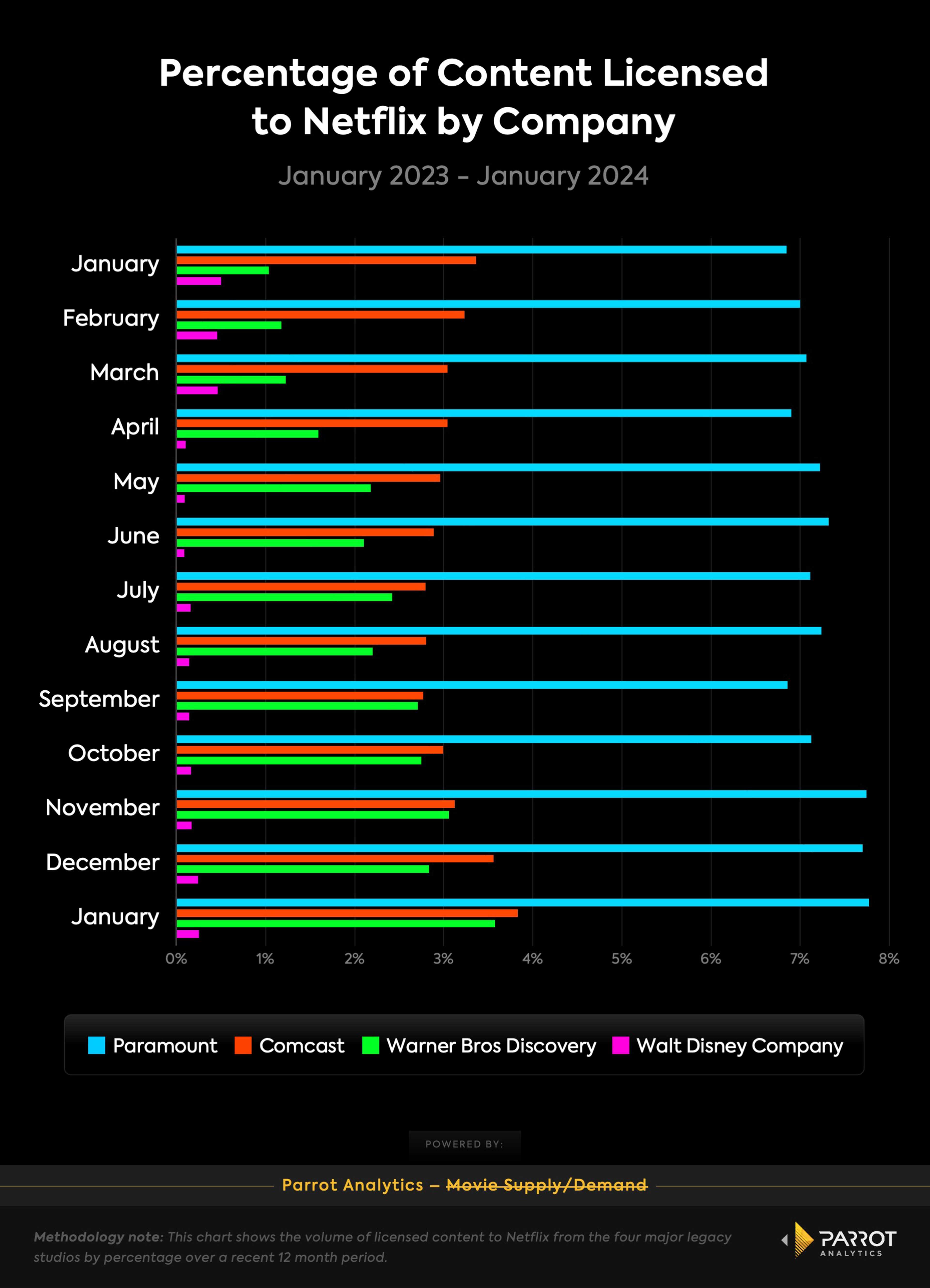
This can help Lin accomplish another of his goals as he “wants his team to become more aggressive producers — developing their own material rather than waiting for projects from producers and agents to come to them,” the New York Times reports. Original movies such as The Power Of The Dog and Enola Holmes have led on-platform demand ranking in the quarters following their releases. Yet overall, there is more demand for licensed movies from other studios than Netflix’s own crop of films. For now, at least. (It’s worth noting that exclusive content is still a significant contributor to churn reduction).
The company obviously does not have a century old war chest of major intellectual property to leverage or library titles to recycle à la Disney or Paramount. Creating franchises from scratch is unsurprisingly difficult and the prospects of future installments for expensive attempts such as Red Notice, 6 Underground, The Heart of Stone and perhaps even Rebel Moon are unclear. But relying on licensed content in order to provide more development time for in-house franchise investments can help. When your platform has a steady stream of Sony releases, Universal animation titles, and select biggies from Warner Bros., it can devote more resources toward IP acquisition and maximizing the development and pre-production windows to assuage quality concerns.
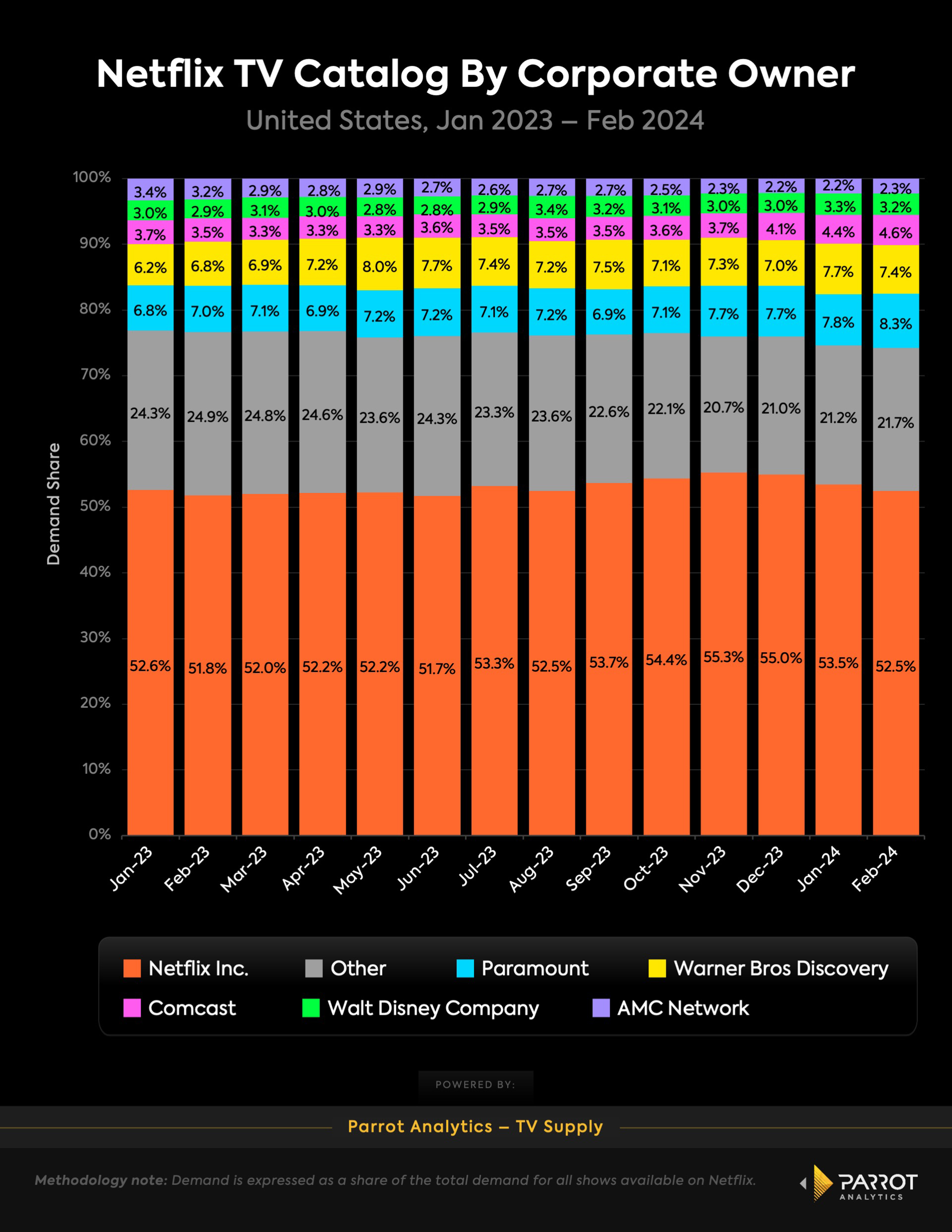
More importantly, understanding the narrative and audience DNA of popular licensed franchise titles, as well as consumption affinity habits, can also help with original development. For example, those that watched The Super Mario Bros. Movie — streaming on Netflix in its segmented Pay 1 deal — in the last week (as of this writing) also watched Spider-Man: Across the Spider-Verse, Avatar: The Way of Water, Wonka as well as John Wick: Chapter 4, Mission: Impossible—Dead Reckoning and The Equalizer 3, according to Parrot’s affinity data.
This tells us two things. First, the younger audiences are likely drawn to the colorfully compelling visual aesthetic of the more family-friendly skewing animated and live-action titles. Unique production design with an immersive palette and VFX slate is a strong selling point. The excellent The Mitchells vs the Machine, which Netflix acquired from Sony Pictures Animation, and The Sea Beast are good examples of these learnings being applied in the company’s original library. Second, slightly older audiences are drawn to kinetic action and impressive stunt choreography; big show-stopping action set pieces that can truly wow. Extraction and The Old Guard are good examples here. The deeper Netflix digs into what subscribers enjoy specifically about these licensed titles, the more insights it can unearth for its own originals.
Conclusion
Despite the still nauseating conclusion, Game of Thrones was ultimately a captivating exploration into the nature of power and the ways in which it is used to enact change. Perhaps that’s a bit too grandiose to compare directly to Netflix’s situation, but the underlying symmetry remains.
Netflix is changing the way in which it approaches a central element of its business which will have a major impact on consumers. The goal of emphasizing quality over quantity to create a more trusted and lasting cinematic footprint is both admirable and likely more cost-effective. The upside is clear from a creative and financial standpoint. But it also entirely execution dependent, which presents a far more serpentine path forward.
There’s risk of losing engagement in such a strategic transition, though always the promise of great rewards. As such, Netflix shouldn’t be afraid of further experimentation in order to discover which approaches may work better and which can be confidently put to bed. The power players of Westeros may not have had the freedom for such trial and error, but Netflix does and it will be better off because of it.
